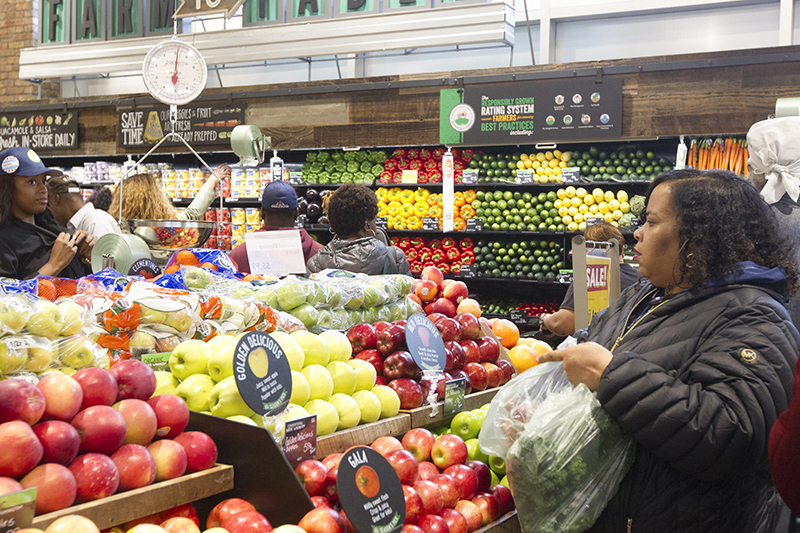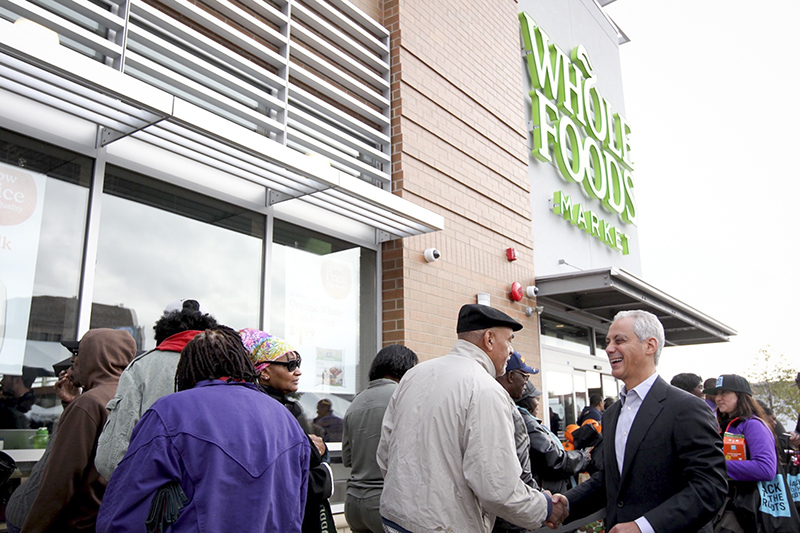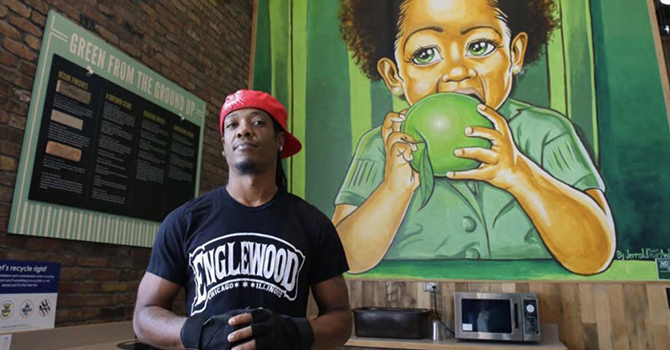Update: Whole Foods announced it was closing the Englewood store in April 2022.
In some ways, the Whole Foods in the Englewood neighborhood on Chicago’s South Side looks the same as Whole Foods does everywhere; there are pyramids of avocados and bouquets of fresh-cut flowers. But it also has unique touches, such as a small children’s lending library and a mural of the neighborhood.
The Englewood Whole Foods is more than a place to grab groceries. For residents of this low-income neighborhood, it’s also a community hub, a lunch and dinner spot, and a significant employer -- as well as a source of hope.
2019 Traditioned Innovation Award Winner
Leadership Education at Duke Divinity recognizes institutions that act creatively in the face of challenges while remaining faithful to their mission and convictions. Winners receive $10,000 to continue their work.
“It feels good to walk there and get whatever I want that’s healthy,” said resident Asiaha Butler, who is the co-founder and executive director of the Resident Association of Greater Englewood. “And I love that I see my neighbors there. It’s almost like ‘Cheers’ -- there’s always somebody who knows my name.”
Whole Foods has a reputation for high prices. Englewood has a reputation for poverty and violence. So how has this establishment flourished in this neighborhood?
In part, it’s through the efforts of Englewood’s Canaan Community Church and its pastor, the Rev. Jonathan Brooks.
“The purpose of this church will always focus around the community,” said Brooks, who also goes by “Pastah J.” “We believe that it’s not enough to just open a church and have services. How can you be a representative for those who are most harmed by society? Those are the people whom the people of God should be standing up for, advocating [for] and living with.”

Changing the narrative in Englewood
Englewood has long had a reputation as one of Chicago’s most troubled and dangerous neighborhoods. More than 40 percent of its families live below the poverty line, and in 2018 alone, there were some 50 homicides, including one of a 15-year-old girl sitting on her front porch.
But Brooks and other community leaders see Englewood through a different lens -- one of hope, community, peace and promise.
“You are created in the image of God,” Brooks said. “That is what Genesis tells us about ourselves. If I can begin to see myself and the world the way God does, I can begin to chip away at the hopelessness, by changing the narrative.”
What role does your organization play in your community's narrative? Could you take part in changing it?
The primary way he works toward that change is making sure that his church is devoted to the community’s needs.
As Brooks details in his recent book, “Church Forsaken: Practicing Presence in Neglected Neighborhoods,” loving our neighbors, to him, means loving our neighborhoods -- and loving them in the most visible, concrete, day-to-day ways.
“The kingdom of God is not someplace we’re going to,” he said. “The kingdom of God is at hand, and we are supposed to be living out God’s principles for the world now. That’s what God desires us to do.”
Before Brooks became pastor of Canaan in 2006, the congregation had for decades been largely worshippers who lived in other, more affluent areas of the city.
“Which is what a lot of African-American churches deal with,” he said. “They started as parish-style churches, where everybody lived in the neighborhood. Then people moved to the suburbs, but they wanted to stay connected to the church they grew up in. That’s what Canaan was.”
That didn’t sit well with him.
“God gave a very distinct command to Israel, and the command was: ‘To the ones I sent into exile, plant gardens, build houses, settle down. Seek the peace and welfare of the city where I sent you,’” he said, citing Jeremiah 29.
“What I love about the passage is that God tells them to seek the welfare, not of their family, not of their immediate folks, but of the entire place. Because you live in that place.”
And so, 13 years later, Canaan has gone from being a commuter church to one where most of its congregants walk to Sunday services. (There is no parking lot.) And it has become a church fiercely devoted to bettering Englewood and the lives of the people who live there.
An oasis in a food desert
That’s why in 2012 it held a community meeting to ask, “What are the issues that we, as a neighborhood, can begin to solve?” High on the list was food access.
For years, there had been few grocery stores in the neighborhood, and they weren’t known for their food’s freshness or their convenience.
Has your organization ever asked community members what needs it could help address?
“It took a bus or two to get there, and it wasn’t even high-quality food,” Brooks said. “There were no healthy-food grocery stores anywhere in the vicinity. People were frustrated.”
The USDA estimates that more than 23 million Americans live in “food deserts” -- areas where geography, transportation and other factors prevent them from easily accessing fresh, healthy food. Low-income neighborhoods are especially vulnerable.
“Retailers, of course, want to locate where they can make a profit,” said Shannon Zenk, a professor of health systems science at the University of Illinois-Chicago who studies food deserts.
Further, she said, “if you compare white low-income neighborhoods and African-American low-income neighborhoods, there is some evidence that supermarkets are less likely to locate in low-income African-American neighborhoods.”
In 2011, Chicago Mayor Rahm Emanuel declared a goal of eradicating food deserts from the city by 2020. But Brooks and his congregants didn’t see the point of waiting for elected officials to fix the food problem in Englewood.

Instead, they formed something called the 5 Loaves Food Cooperative. The concept was simple: Each week, co-op members would pool their money, and a couple of them would drive to a Trader Joe’s in another neighborhood and bring back milk, eggs, bread, vegetables and other staples. Then everyone would come together at the church to shop.
Eventually, Trader Joe’s began donating to the co-op food that was approaching its best-if-sold-by date, as well as giving it a bulk discount on the items purchased. That meant that each co-op member could chip in just $1 (now $5) and be able to fill up at least one bag with groceries.
Canaan intentionally started a buying cooperative rather than a food pantry. Are there empowering ways you could help meet community needs?
“We have shopping carts and everything,” said parishioner Beverly Moores. She oversees the co-op, which currently has about 50 members, not all of whom attend Canaan, and some of whom are students. The only requirement for membership is living in Englewood.
The co-op, she says, makes it easier for residents who have food allergies, gluten sensitivity or other dietary restrictions to access the alternatives they need. And as they shop together, the members share tips and recipes.
“You’d be amazed at the number of people you hear asking each other, ‘What is this [ingredient], and what is it for?’” she said. “We learn from each other.”
The co-op has also taken steps toward creating its own community garden, so that members can grow their own produce.
“We really want a lot of fresh, homegrown food there. You really see the difference in the taste,” Moores said.
Connecting the community to Whole Foods
While Canaan and the 5 Loaves co-op were busy feeding their neighbors, larger wheels were turning elsewhere.
One day a few years ago, Brooks learned from his friend David Doig that the city was negotiating with Whole Foods about the prospect of opening an outpost in Englewood. As the president of an organization called Chicago Neighborhood Initiatives, Doig helps facilitate economic development in low- to moderate-income neighborhoods.
That bolt wasn’t as out-of-the-blue as it might seem. Since at least 2005, when a local nonprofit coalition called Teamwork Englewood had created a quality-of-life plan, there had been attempts to attract a grocery store to the area. Now Whole Foods had gotten wind of it -- and then-CEO Walter Robb wanted community input about the idea of opening a store there.
The effort to bring Whole Foods to Englewood involved many partners, not just the church. Where are the people already working to bring change in your community?
Brooks was nervous about floating the prospect to residents. “Whole Foods’ prices are super high!” he remembers thinking. “How are we going to make this work?”
Reactions were similar when he put the issue in front of other local leaders. Asiaha Butler, of the Englewood resident association, recalls her initial response: “Out of all the stores, you pick a really expensive one to come into this community?”
But gradually, as Whole Foods representatives -- including Robb himself -- met with the community to listen to their concerns, a way forward emerged.

If a Whole Foods was built in Englewood, the grocery chain promised, its prices on staples such as milk and bread would be lower than in other Whole Foods locations. It would hire community residents and offer them health insurance. It would put products from local vendors on the shelves. Its interior design would reflect the spirit of the community.
Brooks found himself surprised by the chain’s willingness to listen to and truly address Englewood’s needs.
“I had pegged them” as potential gentrifiers, he said. “The very thing I hate, my neighborhood being defined by an outside narrative versus a real relationship -- I did the same thing to Whole Foods. And they showed me that, no, they care about people, not just profits. I saw it with my own eyes.”
Brooks acknowledges his own impulse to pre-judge the Whole Foods company. Are you aware of your own biases and prejudices?
So when Brooks got a direct call from Whole Foods headquarters saying, “Hey, we know that you guys have this food cooperative a lot of people seem to trust. Would you endorse Whole Foods’ entrance into the neighborhood?” he decided that he was willing to help them connect to the community -- the people that, in the end, were their potential customers and employees.
The Englewood Whole Foods opened its doors at 63rd and Halsted in September 2016, part of a shopping center and larger parcel under development. It drew more than 3,000 shoppers on its first day with a grand-opening event that featured a parking-lot barbecue, dancing, DJs and a gift-card giveaway.

“Working alongside the many individuals and organizations bringing positive change in their community was inspiring. … We’ve had the privilege to support the next class of food innovators, leaders and entrepreneurs of the South Side,” Robb said in a press release.
Since then, other businesses have opened nearby, including a Starbucks committed to hiring (and giving benefits to) community members. And the grocery store – which employs more than 100 people -- has become a community center of sorts, with regular cooking classes and wine tastings.
On a recent weekday, Englewood resident Michelle Rashad, who works within walking distance of the Whole Foods, sat in the store’s dining area to enjoy lunch from its hot-food bar.
“This chicken might be $1 more, but it doesn’t have hormones in it,” she said. “It’s the quality -- that’s what matters to me. I’m very big on mental health care in the black community, and what we eat determines how we act.”
It’s not just about food
Having a Whole Foods in the community doesn’t eliminate the need for 5 Loaves. The grocery store lies slightly more than 2 miles from Canaan, meaning it’s still more practical for those who live near the church to shop at the co-op. But that’s OK, Brooks said. This was never about replacing the co-op but about bettering the lives of all the residents of Englewood and helping them see themselves and their neighborhood differently.
He points to a familiar Bible story -- the one in which Jesus asks a Samaritan woman for some water.
“And her response is not, ‘Sure, I can give you some water.’ It’s, ‘How can you, a Jewish man, even speak to me, a Samaritan woman?’ And he spends the rest of the conversation trying to convince her that she’s worthy of being spoken to,” Brooks said.
“She had fallen hook, line and sinker into the [idea] that she wasn’t good enough. That’s the same thing with residents of neighborhoods that don’t even believe that they deserve something like a Whole Foods.”
That’s where reminding people that they are made in the image of God can begin to eradicate internalized hopelessness, he said.
And once hope rises, he said, “we become the tangible hands of Christ, so that people begin to see: Maybe I had it wrong about this Jesus guy. Maybe he does care about my everyday life right now. Maybe he doesn’t just want me to have a good life someday in heaven but wants me to have an abundant life right now on earth.”
Questions to consider
Questions to consider
- What role does your organization play in your community's narrative? Could you take part in changing it?
- Has your organization ever asked community members what needs it could help address?
- Canaan intentionally started a buying cooperative rather than a food pantry. Are there empowering ways you could help meet community needs?
- The effort to bring Whole Foods to Englewood involved many partners, not just the church. Where are the people already working to bring change in your community?
- Brooks acknowledges his own impulse to pre-judge the Whole Foods company. Are you aware of your own biases and prejudices?










